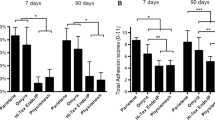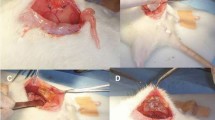Abstract
Background
Adhesions after intraabdominal surgical procedures are related to high morbidity and mortality. Biomaterials, particularly those made of polypropylene, in the intraabdominal position have to be considered as pathophysiological cofactor in a multifactorial process of adhesion formation. To investigate the adhesive potential induced by the biomaterial, an animal model was performed. In addition, the influence of coverage by omentum or a polyglactin barrier was investigated.
Methods
In, 18 Chinchilla rabbits the biomaterial was placed laparoscopically using the intraperitoneal onlay mesh technique. Using this model, a polypropylene–polyglactin mesh compound (PPMC) was used with three different implantation techniques: group 1, PPMC implantation without coverage (PPMC): group 2, PPMC implantation with additional omentum coverage (PPMC-O): and group 3, PPMC implantation with coverage of an absorbable polyglactin mesh (PPMC-V). The degree of adhesion formation was measured 90 days after implantation by computer-assisted planimetry. Morphometric examination followed the explantation analyzing the amount of foreign body response.
Results
We found a significant reduction of adhesion formation for the PPMC and PPMC-O groups compared to the PPMC-V group, in which dense adhesions were found. Morphometric investigations of the perifilamental granulomas of the pure (PPMC) group revealed a typical foreign body reaction with a mild to moderate fibrosis around all mesh fibers. However, tissue specimens of the PPMC-O and PPMC-V groups indicated a similar inflammatory reaction but significantly increased connective tissue formation around the polymer fibers compared to the pure PPMC group.
Conclusion
The intraabdominal placement of a pure PPMC shows a neoperitonealization and perifilamental collagenous ingrowth with almost no adhesions. Coverage with omentum (PPMC-O) or polyglactin mesh (PPMC-V) resulted in a significant increase in inflammation and perifilamentary connective tissue formation.




Similar content being viewed by others
References
ML Baptista ME Bonsack JP Delaney (2000) ArticleTitleSeprafilm reduces adhesions to polypropylene mesh Surgery 128 86–92 Occurrence Handle10.1067/msy.2000.106810 Occurrence Handle10876190
E Barlehner R Schwetling (1996) ArticleTitleLaparoscopic repair of incisional hernias Zentralbl Chir 12l 307–312
RH Beelen (1991) ArticleTitleThe greater omentum: physiology and immunological concepts Neth J Surg 43 145–149 Occurrence Handle1787897
JM Bellon LA Contreras J Bujan A Carrera-San Martin (1997) ArticleTitleThe use of biomaterials in the repair of abdominal wall defects: a comparative study between polypropylene meshes (Marlex) and a new polytetrafluoroethylene prosthesis (Dual Mesh) J Biomater Appl 12 112–135
JM Bellon LA Contreras J Bujan D Palomares A Carrera-San Martin (1998) ArticleTitleTissue response to polypropylene meshes used in the repair of abdominal wall defects Biomaterials 19 669–675 Occurrence Handle10.1016/S0142-9612(97)00162-2 Occurrence Handle9663739
R Bendavid (1997) ArticleTitleComposite mesh (polypropylene-ePTFE) in the intrageritoneal position A report of 30 cases Hernia 1 5–8
RP Bleichrodt RK Simmermacher LB . Particlevan der JM Schakenraad (1993) ArticleTitleExpanded polytetrafluoroethylene patch versus polypropylene mesh for the repair of contaminated defects of the abdominal wall Surg Gynecol Obstet 176 18–24 Occurrence Handle8427001
J Bujan LA Contreras A Carrera-San Martin JM Bellon (1997) ArticleTitleThe behavior of different types of polytetrafluoroethylene (PTFE) prostheses in the reparative scarring process of abdominal wall defects Histol Histopathol 12 683–690 Occurrence Handle9225151
MA Carbajo JC Martp Olmo Particledel JI Blanco M Toledano CC la Particlede C Ferreras C Vaquero (2003) ArticleTitleLaparoscopic approach to incisional hernia Surg Endosc 17 18–122 Occurrence Handle10.1007/s00464-002-9079-0
PK Chowbey A Sharma R Khullar V Soni M Baijal (2003) ArticleTitleLaparoscopic ventral hernia repair with extraperitoneal mesh: surgical technique and early results Surg Laparosc Endosc Percutan Tech 13 101–105 Occurrence Handle10.1097/00129689-200304000-00008 Occurrence Handle12709615
PM Christoforoni YB Kim Z Preys RY Lay FJ Montz (1996) ArticleTitleAdhesion formation after incisional hernia repair: a randomized porcine trial Am Surg 62 935–938 Occurrence Handle8895716
C Durstein-Decker WG Brick TR Gadacz DW Grist RK Ivey KW Windom (1994) ArticleTitleComparison of adhesion formation in transperitoneal laparoscopic herniorrhaphy techniques Am Surg 60 157–159 Occurrence Handle8116972
B Eckmann AF Holstein HW Schreiber (1985) ArticleTitleThe surface of the greater omentum in the human and its vulnerability in intra-abdominal surgical interventions Langenbecks Arch Chir 365 91–99 Occurrence Handle10.1007/BF01261136 Occurrence Handle4046687
R Eller R Bukhari E Poulos D Mclntire E Jenevein (1997) ArticleTitleIntraperitoneal adhesions in laparoscopic and standard open herniorrhaphy An experimental study Surg Endosc 11 24–28 Occurrence Handle10.1007/s004649900288 Occurrence Handle8994983
L Farmer M Ayoub D Warejcka S Southerland A Freeman M Solis (1998) ArticleTitleAdhesion formation after intraperitoneal and extraperitoneal implantation of polypropylene mesh Am Surg 64 144–146 Occurrence Handle9486886
ME Franklin JP Dorman JL Glass JE Balli JJ Gonzalez (1998) ArticleTitleLaparoscopic ventral and incisional hernia repair Surg Laparosc Endosc 8 294–299 Occurrence Handle10.1097/00019509-199808000-00012 Occurrence Handle9703605
AL Halverson WL Barrett P Bhanot JE Phillips AR Iglesias LK Jacobs JM Sackier (1999) ArticleTitlelntraabdominal adhesion formation after preperitoneal dissection in the murine model Surg Endosc 13 14–16 Occurrence Handle10.1007/s004649900888 Occurrence Handle9869680
SD Jenkins TW Klamer JJ Parteka RE Condon (1983) ArticleTitleA comparison of prosthetic materials used to repair abdominal wall defects Surgery 94 392–398 Occurrence Handle6224307
U Klinge B Klosterhalfen V Birkenhauer K Junge J Conze V Schumpelick (2002) ArticleTitleImpact of polymer pore size on the interface scar formation in a rat model J Surg Res 103 208–214 Occurrence Handle10.1006/jsre.2002.6358 Occurrence Handle11922736
GE Leber JL Garb Alexander Al WP Reed (1998) ArticleTitleLong-term complications associated with prosthetic repair of incisional hernias Arch Surg 133 378–382 Occurrence Handle10.1001/archsurg.133.4.378 Occurrence Handle9565117
HS Matloub P Jensen BK Grunert JR Sanger NJ Yousif (1992) ArticleTitleCharacteristics of prosthetic mesh and autogenous fascia in abdominal wall reconstruction after prolonged implantation Ann Plast Surg 29 508–511 Occurrence Handle1466546
N Mori K Takano T Miyake T Nishio S Muto K Koshizuka H Nakagomi M Kubo Y Tada (1998) ArticleTitleA comparison of prosthetic materials used to repair abdominal wall defects Pediatr Surg Int 13 487–490 Occurrence Handle10.1007/s003830050379 Occurrence Handle9716675
GJ Morris-Stiff LE Hughes (1998) ArticleTitleThe outcomes of nonabsorbable mesh placed within the abdominal cavity: literature review and clinical experience J Am Coll Surg 186 352–367 Occurrence Handle10.1016/S1072-7515(98)00002-7 Occurrence Handle9510268
V Schumpelick K Junge R Rosch U Klinge M Stumpf (2002) ArticleTitleRetromuscular mesh repair for ventral incision hernia in Germany Chirurg 73 888–894 Occurrence Handle10.1007/s00104-002-0535-0 Occurrence Handle12297953
MH Seelig R Kasperk L Tietze V Schumpelick (1995) ArticleTitleEnterocutaneous fistula after Marlex net implantation. A rare complication after incisional hernia repair Chirurg 66 739–741 Occurrence Handle7671764
RK Simmermacher JM Schakenraad RP Bleichrodt (1994) ArticleTitleReherniation after repair of the abdominal wall with expanded polytetrafluoroethylene J Am Surg 178 613–616
InstitutionalAuthorNameSurgical Membrane Study Group (1992) ArticleTitleProphylaxis of pelvic sidewall adhesions with Gore-Tex surgical membrane: a multicenter clinical investigation. The Surgical Membrane Study Group Fertil Steril 57 921–923
WW Vrijland J Jeekel EW Steyeberg PT Hoed ParticleDen HJ Bonjer (2000) ArticleTitleIntraperitoneal polypropylene mesh repair of incisional hernia is not associated with enterocutaneous fistula Br J Surg 87 348–352 Occurrence Handle10.1046/j.1365-2168.2000.01364.x Occurrence Handle10718806
Acknowledgment
This study was supported by Ethicon, Norderstedt, Germany.
Author information
Authors and Affiliations
Corresponding author
Rights and permissions
About this article
Cite this article
Conze, J., Junge, K., Klinge, U. et al. Intraabdominal adhesion formation of polypropylene mesh Influence of coverage of omentum and polyglactin. Surg Endosc 19, 798–803 (2005). https://doi.org/10.1007/s00464-004-2192-5
Received:
Accepted:
Published:
Issue Date:
DOI: https://doi.org/10.1007/s00464-004-2192-5




